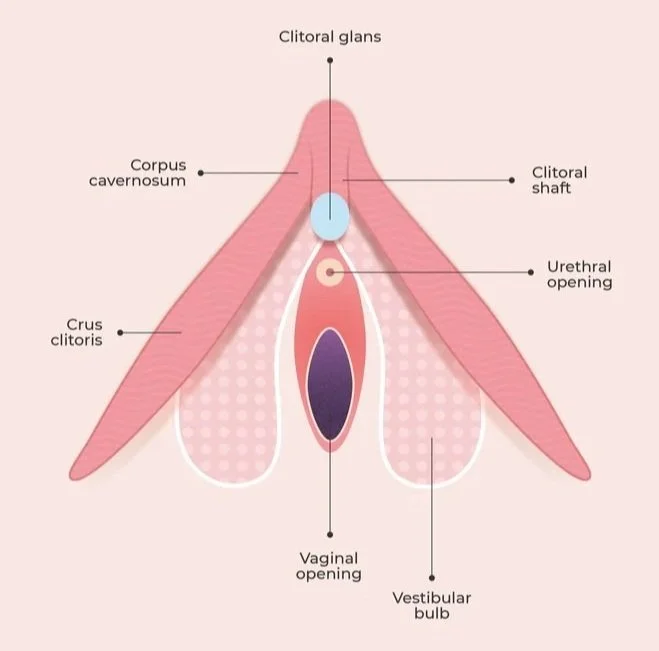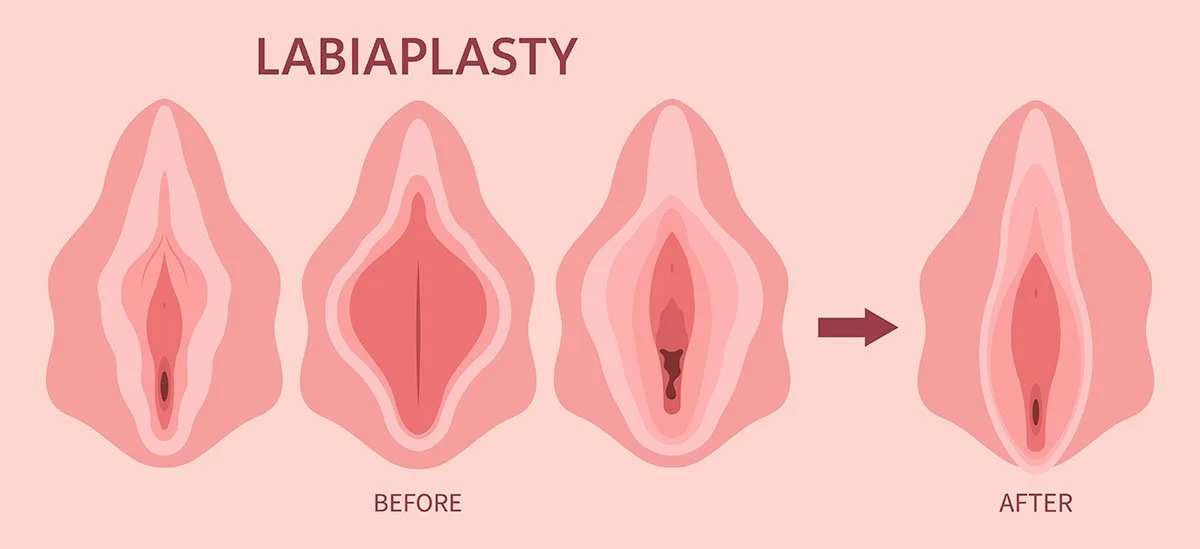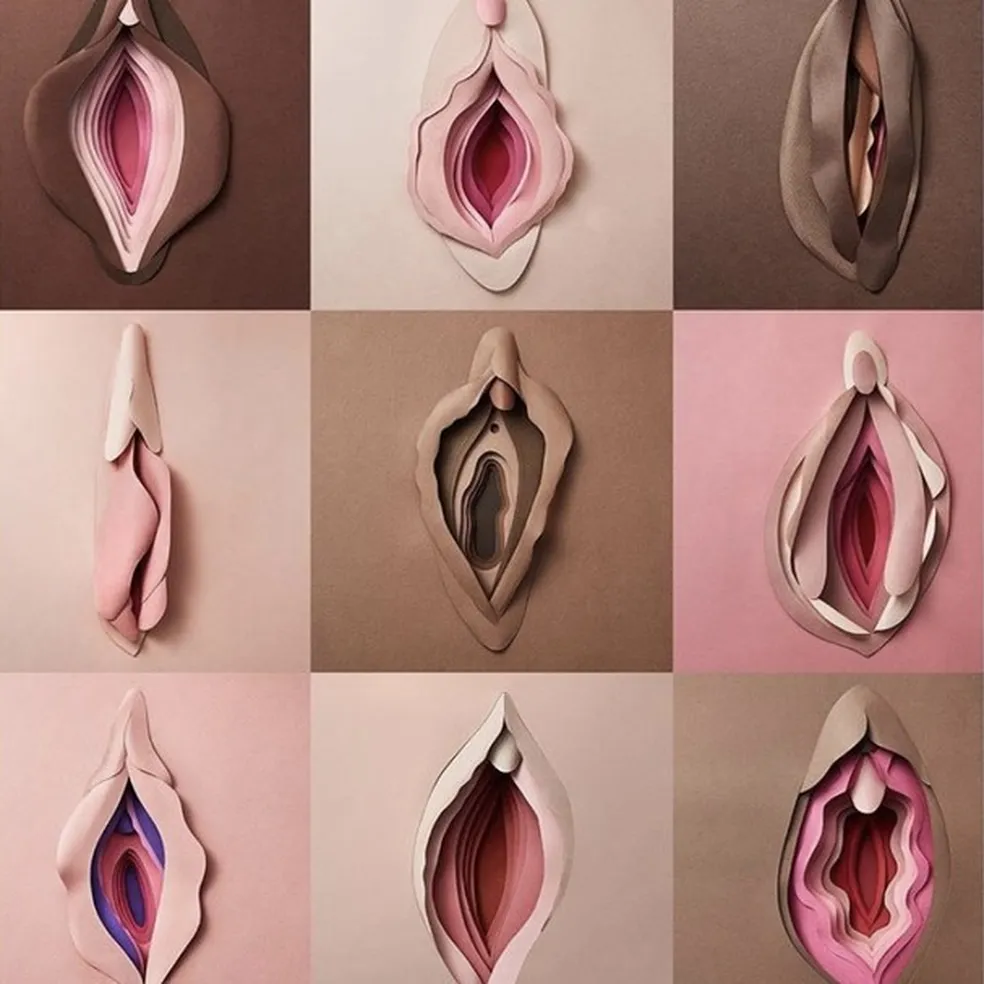Learning to Love Your Vulva: Healing from Shame in 3 Steps
Fat vulvas are in style
I recently had a good laugh about how “thicker labias” are supposedly back in style. Honestly, I’ve never lived through a time when they were considered “in,” so maybe this is their first time making an appearance—who knows? And how can a body be fashionable anyway. Our bodies are not a fashion trend, they shouldn’t be altered, cut and padded like a coat.
This new vulva trend sparked a conversation with a friend about how we’d grown up completely unaware of just how many different ways vulvas can look. Only recently—thanks to social media—have we started seeing those illustrations where you’re like, Ohhh, so vulvas can actually look really different!
My friend wondered: “But where did we even get the idea of what a vulva “should” look like?” It is a good question. Luckily I knew the answer since other beautiful women have done a lot of work in this field and have imparted their wisdom on me.
So in this post I want to share with you lovely ladies what I know. I hope this post finds all the women who are feeling insecure about their labias, their folds, their clitoris… their vulva. We also will touch on sexual pleasure and on ways how to make peace with what you got going on down there. So let’s make you fall in love with your vulva.
I hate my vulva.
Liliya Rodnikova
The misrepresentation of vulvas
How did we learn about what a vulva looks like? The answer sadly is: Porn. (And school books but let’s get to that later.)
In the adult film industry, many women undergo cosmetic surgery on their labia. There’s also anal bleaching and other procedures, so everything ends up looking almost identical. That’s what men have been exposed to, and it’s what many of us have seen too.
It’s no surprise that between 2015 and 2020, labiaplasty rates rose 70%! That’s tied directly to how accessible porn is now. When you’re constantly shown one version of a vulva, it’s easy to feel like, Oh, maybe mine isn’t right. Maybe I should just get surgery.
Because if you’re straight, how many vulvas have you actually seen in real life? Probably not that many—unless you’re a lesbian, bisexual, or work in gynecology, in which case, lucky you! You’ve had this knowledge much earlier than the rest of us. For straight women, it’s mostly anatomy drawings in school textbooks and porn. And let’s be honest, those drawings are of teenagers, not grown women, and definitely not grown women who’ve given birth to 2, 3, or 4 kids!
It’s exactly because of this narrow representation that many women—myself included—have felt ashamed about their vulvas. For example, I used to think something was wrong with me because my vulva wasn’t uniformly pink like the ones I’d seen in pictures or porn. I was too embarrassed to talk about it, and I know I’m not alone. Over the years, I’ve had countless conversations with other women about their vulvas—about asymmetry, labia size, color, smell—and we’ve all realized the same thing: It’s all normal.
How sex is portrayed shapes how you see your vulva
Often, the first exposure to sex is through porn. Pornography has moved very far away from reality, distorting the way we think sex should be. Over time, this new version of sexual intercourse has created a new reality for many young adults, where there is a confusing gap between what they would actually find pleasurable in the bedroom versus what they feel they need to do.
Instead of sex being something you do with each other, sex in porn has become something that is done to a woman—something she pretends to like or pretends to hate. In much of porn, her sexual pleasure is not important, and she is used and abused for the safe of male satisfaction. Porn has become more violent and degrading over the last 20 years, and it is scary how that adds to how women feel about their vulvas.
“Girls are taught that being sexual is shameful.
Boys are taught that sexualizing girls is normal.
And then women learn that it’s normal to be sexualised by men. While men learn that it’s shameful for women to be sexual.
And so women struggle to enjoy their bodies when they are expected to behave as objects.
While men struggle to respect women’s bodies when they are expected to see them as objects.”
Our bodies are not seen as a place of pleasure and love. Instead, the vulva often carries the weight of degradation, objectification, violence, shame and disgust.
Of course, you don’t love your vulva. In school, you are only taught about reproduction. In porn, you are taught about degradation and domination. From society, you learn that the vulva is dirty and that you shouldn’t be asking “for it.” Women wanting sex and enjoying sex have been stigmatized since patriarchy took hold around 12’000 years ago (3000 to 8000 BC), framing female sexuality as something to control, suppress, or shame rather than a normal thing that also happens to produce life and uphold societies.
The truth about vulvas
Your vulva is an incredible organ. Your uterus can grow a whole human being. You can create life itself! The ability to change and shift just right so that a baby can move through your pelvis and out of the vagina is incredible. No, seriously—if you have given birth vaginally, then you know that this is just crazy. (And if you couldn’t but wanted to deliver vaginally, I send you love.)
How is the vulva—the place life comes from—burdened with so much shame? We would literally not be here as a society if we didn’t have the ability to have sex and give birth! I refuse! I refuse to take on that shame!
Your vulva is a miracle.
The second truth? Your vulva has the potential to feel enormous amounts of pleasure. There are so many nerves down there—isn’t it absolutely mind-blowing? It is a place that should be loved, played with, and cared for. And honestly, because there has been so little discussion of female pleasure it has became a “nice to have” in the bedroom rather than a right to equal pleasure.
This is the truth about our vulvas: they are impressive, genius, and complex.
“Women often want ‘it’ as much as men do (sometimes more).
What often stops us from being able to express that is the stigma around women wanting it and the fact that we cannot take our safety or satisfaction as a given.”
But isn’t it called vagina? Vulva sounds weird!
This is your vagina
I have honestly struggled so hard to use the word vulva. I grew up calling my vulva vagina. That’s what I had been told that part of my body was called. Interestingly enough, that is very wrong. It is your vulva; you should be able to call it by its name without feeling shame or embarrassment! Since I have children I only use the correct term because I want both my kids and anyone I work with to be able to own that word. So here we go, this is a text book version of the female reproductive system and your vag.
It is only the short canal between the entrance and the cervix. Literally where you would have penetrative sex and where the baby comes out. Funnily enough, not where you get the most pleasure because women are only taught about their genitalia as reproductive organs.
This is your vulva
And while we are at it, here is your vulva in full. Although keep in mind that this is a misrepresentation since this is a “standard picture” of how women and men think a vulva looks like.
All of this (makes a circle motion) is your vulva. And on the picture you can also see a small part of the clitoris. The clitoris shown in the picture above is not “the” clitoris because our clitoris is actually pretty impressive.
Meet “the” clitoris—she is big.
These are your ovaries
Since we are here, let’s also clear up the myth of your fallopian tubes and ovaries. They are not where you think they are. Ugh, I was so confused at every pregnancy scan when they checked the ovaries. I didn’t get why she looked so close to my uterus since I expected the ovaries to be much farther out! I literally haven’t even once seen an accurate picture before 2024!
Mental health issues and shame about what you’ve got going on down there
As a teen or young adult, it’s common to feel unsure about your body—to the point where shame about how you look can deeply impact your mental health. When it comes to our vulvas, though, the issues run much deeper. We are taught that anything regarding sex and sexuality is deemed sinful and dirty. Therefore, a woman’s pleasure is not talked about nor is it a priority. Women are supposed to have sex, but enjoying it is not quite permitted. Men’s pleasure is at the center, and women are made to feel like sluts if they enjoy sex with men. In German, the word for vulva is “die Scham.” That directly translates to “the shame.” The part between your legs is “der Schambereich,” which translates to “the zone of shame.”
It’s not your own crazy brain coming up with this shit. We are taught to dislike, to feel disgusted by, and to ignore that part of us. Add on sexual trauma, and you’ve got a pretty potent cocktail to prevent you from making peace with your vulva or developing a pleasurable sex life.
No wonder some women hate their vulva enough to want to get labiaplasty to make it at least look “pretty”—aka textbook or porn standard.
Below is an excerpt from a paper reviewing trends in labiaplasty, which documents a concerning rise in teenage girls requesting corrective surgery. While the authors recommend postponing labiaplasty until adulthood, they also highlight the importance of education and addressing underlying concerns.
"Genital anatomy is more diverse than we previously thought and there is evidence to suggest that the labia minora, with their rich innervation, play an important role in sexual arousal and pleasure. Education regarding the wide range of normal genital appearance suffices in most cases to dissolve concerns regarding body self-image. Mental health issues should always be explored and, if identified, the girl should be referred to an experienced professional for their resolution."
While the paper raises some valid points, I take issue with how it frames concerns about labia size or shape as a girl's "mental health issues." It is not a mental health issue when all the media suggest that there is only one type of vulva—pink and small. Of course, a young girl will worry about how “abnormal” she looks and feel insecure. That is not a mental health issue; that is a normal reaction to the misrepresentation of a woman’s anatomy.
She accurately perceives her vulva as abnormal. She is fine! The world, however, is not.
So what do vulvas look like?
Charlie xcx - Guess
Facts about real vulvas
Some people have labia that are thicker, thinner, and there’s all kinds of different textures. The color of labia is also not the same in all bodies and doesn’t always match the color of the surrounding skin. According to the Gynodiversity Project:
73% of women have a clitoral hood and/or labia that show. So in most women, the inner parts are actually showing.
And in 43% of women, both the clitoral hood is visible and the labia minora protrude past the majora!
48% of women have asymmetrical labia minora.
Only 27% of women have labia minora that are completely hidden—that’s the textbook version we think is normal.
The takeaway message: Those labia are named very inaccurately. Nothing majora and minora about them. They all come in different shapes and sizes—and colors.
So now that we’ve discussed the fact that our vulvas look all very different and most women have their labia minora or clitoral hood showing, let’s talk cosmetic surgery and why it’s not a good idea.
Cosmetic surgery - Labiaplasty
The most common procedure is to reduce and tighten the inner labia. The words the cosmetics surgeons use to promote their services are “rejuvenate” and “youthful” when talking about the ideal outcome. Usually, the goal is to have the labia minora hide like in the anatomy books and porn.
Why is this surgery a bad idea? Because those inner labia are packed with nerve endings! They’re a huge part of your sexual pleasure. If you’ve ever touched yourself when you’re really aroused, you know—there are nerves everywhere down there! Cutting any of that off isn’t just removing tissue. It’s literally reducing your ability to feel pleasure.
Sure, I support a woman’s choice. But the choice to compromise women’s sexual pleasure in order to create a vulva designed by men for male pleasure? No! That’s just not worth it!
Women’s sexual pleasure has been shelved and ignored for long enough. Not looking like a textbook or a porn version of a vulva is not a good enough reason to cut into any body part. Especially not one that is as delicate and complex as the vulva.
The way a woman’s genitalia is discussed says a lot about how they are perceived.
During my research, I came across a comment by a female cosmetic surgeon who advocated for the right to choose whatever makes a woman happy. She also mentioned that the labia minora can be “hypertrophic” and “redundant,” which can cause discomfort.
Redundant? What does that even mean? Nothing about my vulva is redundant.
Terms like "hypertrophic" and "redundant" are not just clinical—they carry connotations of abnormality and excess, implying that these natural variations are problems to be fixed.
Women’s bodies, particularly their genitals, are often discussed in ways that minimize or ignore their functional and sensory value. Framing the labia minora as "redundant" completely overlooks their role in sexual pleasure, reducing them to a cosmetic issue. They are there for a reason. They are there so we can have really nice sex.
Hattie Newman
And since that plastic surgeon brought up the issue of discomfort, let’s dive in, because I do have thoughts on that.
It is a fact that longer labia can pinch or feel uncomfortable if caught in underwear or pants, but let’s put this in perspective: Do you see how often men adjust their penis and testicles in their pants?! Or how many times they accidentally sit on their saggy balls in the heat of summer? Yet, we don’t suggest cutting them off or tightening things up, do we?
Because it would be wild to suggest surgery for their fully functioning genitals just to make them look more “youthful” and tighten things up under the pretext of comfort and choice.
Instead, we see men’s occasional discomfort as normal. And they discuss it as an issue of temperature or how their pants and underwear fit—not as a problem with their anatomy. Nothing a slight jiggle and a reach into the pants can’t fix. So maybe women’s bodies—and their experiences—are normal too and don’t need surgery.
3 Steps to fall in love with your vulva
After reading all this and seeing many pictures of vulvas you might be excited to dive in or maybe you feel like you are really far away from liking your vulva.
It’s true, it might take a long time to unlearn the shame or discomfort you feel when you look at yourself. That process is gradual with lots of mini-milestones so any step you take is progress. Working through that discomfort is so worth it. Because one day, you’ll be able to appreciate your vulva exactly as it is. And when you’re ready, you will have all those nerve endings intact, and you can enjoy great sex!
Don’t let the porn industry, doctors—or anyone else—make you feel ashamed of your vulva. It’s yours, and it’s perfect the way it is.
First Step - Trauma Therapy
If you have experienced physical trauma, emotional trauma, or sexual trauma that is connected to your vulva then therapy is a good first step. It can help tremendously with flashbacks, intrusive thoughts, feelings of shame and unwelcome body sensations. It’s about untangling the thoughts, emotions, and sensory triggers that became knotted during those adverse experiences. You can absolutely create a new and happier future that belongs to you.
Remember: Speaking thoughts out loud holds incredible power—shame cannot thrive in the light of open conversation. And in the end they are just that, a thought—not the truth.
I have supported many, many girls and women through trauma therapy and helped them work through the discomfort they feel toward their bodies. There is nothing you could share with me that I can’t hold with care and compassion.
Second Step - Learn about self-pleasure
Pesci - by Frida Castelli
I recommend you get yourself a fun sex toy and pleasure yourself whenever you feel like it. Do not use porn if possible. This exercise is about self-exploration. Look at it more like a gentle, fun, and intimate massage. Calm, soothing, and from a place of love. Put on nice music or imagine consensual sex with someone but stay with your thoughts on you. Your fingers, toys, thoughts, and breathing are plenty enough to get you going. When you’re ready try to masturbate in front of a mirror. Sometimes it can help to really see ourselves in order to accept ourselves. Do what feels good and explore at your own pace. All of these are suggestions, trust that you know your boundaries and preferences.
Find inspiration: Check out OMGYES and their instagram. Two other women to follow are Shadeen Francis a sex therapist or Leezus who produces sex toys and has some fun content around sex. For sex toys I can recommend Bellesa. The quality is high and the prices are very affordable (not sponsored). If you do use porn check out Bellasa.co they have consensual and ethical free porn.
Extra considerations if you have experienced sexual violence
If you experienced sexual violence then you might want to ditch porn completely, or at least stick to joyful, consensual, happy and female-pleasure-centered porn. Why do I say that? Because if you have experienced sexual trauma, you might be caught up in a cycle of watching violent or non-consensual porn. It is very common for women who have experienced sexual violence to have (be haunted by) fantasies about dominance and punishment. In order to heal yourself it’s important to not expose yourself to that type of content.
Think about the neurons in your brain like a collection of pathways. If there is a road from A to B (problematic emotion/picture to arousal) then anytime you use that connection you reinforce it. In the end A to B is a highway when really you want to disconnect the two and build something that serves you long term.
It is possible to rewire the way you feel about touching yourself and what arouses you. It can take a while to rewire your brain. But after a while of working on it, you will see that you are making progress! You deserve to feel pleasure from a place of happy, gentle, consensual and joyful love.
There are lots of individual circumstances to consider so if you feel that you just can’t do it then seek out help from a trauma therapist. We can support you.
Third Step - Look at yourself
The Great Wall of Vulva - by Jamie McCartney 2011
Oh, that is a difficult one, I know! We never really see ourselves since our vulva is so hidden! It’s so different for men who see their penis and testicles all the time, plus with the added bonus of society letting them be comfortable or even proud of their junk!
If you think that all those vulva paintings are a little cringe and looking at yourself is raising a ton of resistance in your body, I used to feel that way too. But exposure is literally the single best way to reacquaint yourself with your private parts. And hey, you saw so many pictures and drawings today (yes I did that on purpose!), that’s already a great start!
So follow artists who draw or sculpt vulvas. Follow women who talk about them and talk about sexual pleasure. Eventually, take a good look at your own. Watch while you masturbate. Draw it. Sculpt it. Get to know your vulva.
You might think, that’s easy for you to say! It was not. Hand on my heart, I still find it difficult on some days. Women are forced to carry an immense amount of negative emotions and stories on our vulvas. It takes courage and determination to undo what has been done to us. I am always here for a good fight though.
Feeling truly comfortable in your body means making peace with your vulva—and your breasts. To fully be present in your body and claim your space, you’ll eventually need to address the parts of yourself that don’t yet feel like home. You can’t stand fully in your power if you aren’t living in your body with confidence and love.
“Your body is your home. You deserve to inhabit your home fully and comfortably. It should be a place of love, gentleness, and joy.”
Illustrated by Daisy Bernard












